Country guides

Things to do in Norway
Norway is a famously good destination for outdoor adventure tourism, with fantastic skiing, cycling, hiking, climbing, river rafting, and even scuba diving opportunities. The spectacular scenery is popularly enjoyed on cruises and train rides, with much of the tourist activity centring on the famous and extensive network of fjords.
Sognefjord is the largest of the fjords and lures many tourists to Norway with its dramatic vistas and the natural and cultural wealth along its banks. Many visitors start their fjord explorations in Bergen, but Tromsø also offers some glorious fjord cruises.
Tromsø is the gateway to the Arctic and the main attractions in the north are the phenomena of the Northern Lights and the Midnight Sun, which keep travellers arriving year round. Like all the main cities in Norway, Tromsø also boasts some good museums, as well as the unique Arctic Cathedral.
Oslo, the capital, is a cosmopolitan, sophisticated city, surrounded by glorious countryside and promising many sightseeing opportunities for rainy days. The heritage of the Vikings and the great Norwegian explorers can be investigated in Oslo, as well as some of the country's best art galleries. Other popular urban destinations in Norway include Stavanger, Trondheim, and Bergen, the gateway to the fjords that also boasts the historic harbour district of Bryggen.
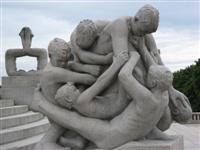
Vigeland Park
Vigeland Museum and Park is Oslo's most visited attraction, and one of the most popular tourist attractions in Norway. It is a vast green area of duck ponds, trees, and lawns that …
Vigeland Park
Vigeland Museum and Park is Oslo's most visited attraction, and one of the most popular tourist attractions in Norway. It is a vast green area of duck ponds, trees, and lawns that is a monument to the celebrated Norwegian sculptor Gustav Vigeland. He spent 40 years creating the life-size statues that decorate the walkways and open spaces.
There are more than 200 works presenting the human form in a variety of poses and conveying a range of emotions. At the centre of the park is the most impressive piece, the Monolith, a gigantic mass of writhing bodies carved from a single column of stone and believed to be one of the largest granite sculptures in the world at a height of 46ft (14m).
Surrounding the column are groups of human sculptures in various forms of interaction with each other. The most famous and most photographed piece is the Angry Boy, a fat child stamping his foot. There are many more sculptures to be seen in the park and in the nearby Vigeland Museum, featuring a display on the development of the artist's work and his sketches and plaster originals.
Visitors should note that although the attraction is commonly called Vigeland Park, the collection of sculptures is technically in a middle section of Frogner Park. Guided tours are available for the museum.
Website www.vigeland.museum.no/en
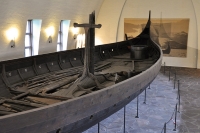
The Viking Ships Museum
Found on the Bygdoy Peninsula, the Viking Ship Museum houses three 9th-century Viking ships that were excavated from ritual burial mounds in the south of Norway. Their excellent co…
The Viking Ships Museum
Found on the Bygdoy Peninsula, the Viking Ship Museum houses three 9th-century Viking ships that were excavated from ritual burial mounds in the south of Norway. Their excellent condition is due to the clay in which they were preserved. Viking ships were used as tombs for royalty who were buried with everything they might need in their life after death.
The biggest and best preserved of the ships is the Gokstad, and the finest is the Oseberg, a richly ornamented dragon ship with an intricately carved animal head post, that was the burial chamber of a Viking queen. The elegantly carved sleigh used by the Viking royalty and a hoard of treasure was found on the buried ship and is displayed at the back of the museum.
Raised platforms allow visitors to view the inside of the ships' hulls. The museum is small and not interactive, but the ships are fascinating and make an impact the moment you see them. The museum is considered a must in Oslo and a visit is one of the best ways to get a taste of the intriguing Viking culture.
Most of the displays have some explanation in English, but there is also free wifi in the museum which can be used to get additional information in English. Entrance to the museum is free with the Oslo Pass.
Website www.khm.uio.no/vikingskipshuset/index_eng.html
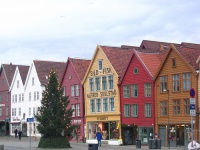
Bryggen
The site of the old medieval quarter of the city of Bergen, Bryggen is a charming, compact area of brightly coloured wooden homes that traditionally housed the city's merchants. Al…
Bryggen
The site of the old medieval quarter of the city of Bergen, Bryggen is a charming, compact area of brightly coloured wooden homes that traditionally housed the city's merchants. Also called Tyskebryggen, its steep cobbled lanes are lined with a vivacious blend of cafes and artisans' workshops.
With many buildings dating from before the 17th century, The Hanseatic wharf area has been declared a UNESCO World Heritage Site and is considered to be one of the most important examples of a medieval settlement in the world.
Bryggen was once the working area of the merchants and is the oldest part of Bergen, characterised by a maze of lopsided wooden buildings with pointed gables facing the harbour. The Bryggen and Hanseatic Museums, as well as the 12th-century St Mary's Church, are all in the Bryggen area.
At one end of the wharf is Bergen's famous fish market, a colourful market also selling flowers, fruit, vegetables, and souvenirs. Because of its predominantly wooden buildings, Bryggen has struggled with fire throughout its long history and many of the structures have been rebuilt several times. One of the unexpected advantages of the destruction caused by fire was the discovery of a wealth of runic inscriptions, now housed in the Bryggen Museum.
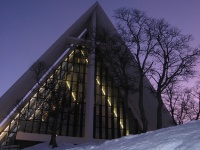
Arctic Cathedral
The spectacular design of the white and ultramodern Arctic Cathedral is visible from afar, situated on a small hill on an island and linked to the mainland by the spindly Tromsø B…
Arctic Cathedral
The spectacular design of the white and ultramodern Arctic Cathedral is visible from afar, situated on a small hill on an island and linked to the mainland by the spindly Tromsø Bridge. It is an architectural masterpiece, made up of eleven large triangular sections representing the eleven faithful apostles and symbolising northern Norwegian heritage, culture and faith.
It bears an interesting resemblance to the Sydney Opera House in Australia, but its colour and shape can also be likened to an iceberg. The cathedral has one of the largest stained glass windows in Europe, and an interior decorated with grand chandeliers made up of many prisms of colours and lights, representing hanging ice formations.
Built in 1965, the church is not technically a cathedral, despite its commonly used name. The actual Tromsø Cathedral is the only wooden cathedral in Norway and is also worth a visit. Travellers should note that the church is usually only open for two hours in the winter months, in the late afternoon, and opening hours can fluctuate so it is best to check the official website to confirm opening hours before visiting. Look out for the wonderful midnight music concerts in the church.
Address Hans Nilsens vei 41, Tromsdalen
Website www.ishavskatedralen.no
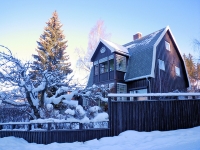
Lillehammer
Lillehammer is best known for hosting the 1994 Winter Olympics and the area does offer excellent opportunities for winter sports such as skiing and snowboarding. In fact, Lillehamm
Lillehammer
Lillehammer is best known for hosting the 1994 Winter Olympics and the area does offer excellent opportunities for winter sports such as skiing and snowboarding. In fact, Lillehammer is considered Norway's oldest winter sports resort.
Lillehammer is picturesque, overlooking Lake Myosa and surrounded by mountains. The village transforms from season to season: a beautiful frozen world in winter and a lush green valley in summer.
In the cold, snowy months, visitors can find some of the best cross-country ski trails in northern Europe at nearby Nordseter and Sjusjoen, and a great ski centre at Hafjell. Lillehammer itself is a very small ski resort, with only about 630 feet (192 metres) of vertical descent and wonderful hiking opportunities in the summer months.
This small town has other attractions too, including Maihaugen, the largest open-air museum in Norway; the 12th-century Garmo Stave Church; and the PS Skibladner paddle steamer. The picturesque main street of Lillehammer is not to be forgotten, lined with charming 19th-century wooden houses. There is a wide selection of shops, restaurants, and accommodation in Lillehammer.
Website en.lillehammer.com
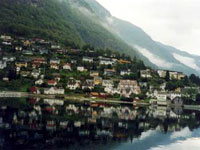
Sognefjord
Sognefjord is the largest fjord in Norway and the second longest in the world, stretching 127 miles (205km) from the coast to the village of Skjolden. Sheer cliffs rise to heights
Sognefjord
Sognefjord is the largest fjord in Norway and the second longest in the world, stretching 127 miles (205km) from the coast to the village of Skjolden. Sheer cliffs rise to heights of 3,300 feet (1,000m) and more above the water.
In addition to some of the most dramatic and magnificent scenery in the world, Sognefjord contains or provides access to many of Norway's most famous tourist attractions. These include three popular national parks, two UNESCO World Heritage Sites, and much more.
Sognefjord offers once-in-a-lifetime experiences for visitors: travellers can see, touch and even walk on one of the largest glaciers in Europe in the Jostedalsbreen National Park; investigate numerous heritage treasures, like the UNESCO-listed Urnes Stave Church in Luster, the oldest church in Norway; marvel at the thundering waterfalls, wild rivers and pristine mountain lakes that feed into the fjord; and explore the steep mountains on either side of Sognefjord, which boast an impressive network of hiking, climbing and skiing trails.
Gorgeous, mostly dry summers and mild winters mean that the fjord can be explored at any time of year, depending on desired activities and adventures. Popular activities in and around Sognefjord include cycling, fishing, hunting, hiking, climbing, kayaking, river rafting, skiing, and canyoning. But those who just want to sit back and enjoy the splendid scenery can take one of the many fjord cruises or even enjoy a train trip.
Website www.sognefjord.no/en


